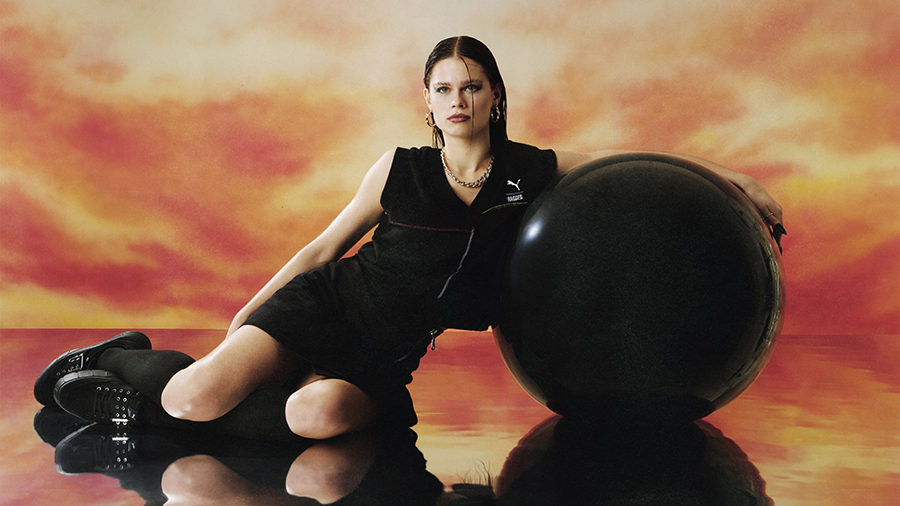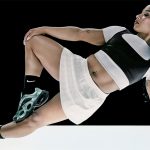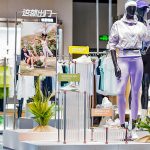Puma SE CEO Arne Freundt revealed company sales in North America declined 18.6 percent in the first quarter, and the company now expects a further decrease in 2023 as Puma reduces its exposure to off-price sellers and elevates its position as a sports brand. The comments were made during a media call to discuss first quarter results.
Freundt, who replaced Bjorn Gulden as CEO at the start of 2023, noted that Puma had cautioned on its fourth-quarter call that business conditions in North America would be challenging “for the whole industry overall” due to a “very high level of inventories” in the marketplace as well as low consumer sentiment tied to high inflation and recessionary concerns. He said, “This has also led to a drop in units for the industry in 2022, and that continued also in Q1 2023.”
Specific to Puma, Freundt said the brand had developed a “relatively high exposure” to the off-price channel. He explained it was due, in part, to off-pricers making pre-order commitments with Puma during the earlier stages of the pandemic when inventories were lean the marketplace. As inventories normalized and are now elevated, Puma faces challenges comping against those orders and projects a sales decline in North America for 2023. Puma plans to refocus on selling through more premium channels.
Freundt said on the call, “In the past, we have focused very much on absolute growth. Now, I would like to change it to make sure we are more focused on the quality of the growth in the U.S. market.”
Freundt, who had formerly been Puma’s chief commercial officer, said reducing off-price exposure and reviving growth in the channels “will take some time,” but he noted Puma had successfully implemented similar shifts to full-price selling in other regions.
“It is clear that 2023 is a transition year for the U.S.,” said Freundt. “It’s a year where we will see business decline, but we will also take the right steps to prepare ourselves to return to growth as of 2024.”
Puma seeks to elevate the brand to improve demand and sell-through at full-price channels to bring the U.S. back to growth. Freundt said, “We need to strengthen its credibility as a sports brand.” He said Puma had a “strong set of athletes and ambassadors,” citing NBA all-star guard LaMelo Ball, American soccer star Christian Pulisic, professional golfer Rickie Fowler, and American long-distance runner Molly Seidel. The goal, he said, is “to amplify them to build up further relevance with the local consumer that we are a true sports brand.”
Regarding product, Puma is developing them specifically for the U.S. market. Freundt said, “With our local product engine, we are creating very good basketball shoes resonating well with our local consumers. We need to use that expertise to further strengthen our product offer by putting the U.S. first.”
On distribution, Puma said it is prioritizing growth and gaining market share at “desirable distribution” wholesale channels, including sports specialty (running stores), athletic specialty, general sporting goods, department stores, and family footwear chains.
Puma will also seek to expand within direct-to-consumer channels that Freundt said play an important role in “storytelling” to help elevate Puma’s positioning.
At the off-price channel, Puma will seek to “contain” its positioning so the channel shrinks as a percent of sales as other channels grow. Freundt said, “We need to consider the off-price channel as more an opportunistic channel and less of a growth channel.” He said a “large majority” of Puma’s decline in the U.S. in the first quarter was due to declines in the off-price channel.
The drop comes after Puma saw strong momentum in the U.S. market from 2019 to 2022. The 18.6 percent decline in the first quarter in North America compares with a 38.5 percent jump in sales on a currency-neutral basis in the 2022 first quarter. On a currency-neutral basis, sales in 2022 in North America grew 13.2 percent in the second quarter, 4.3 percent in the third quarter and 11.7 percent in the fourth quarter.
Encouragingly, the North American region sees “strong momentum” in its strategic performance categories.
“We are continuing to grow our basketball business,” said Freundt. “We’re continuing to grow our Nitro franchises around performance running. We’re continuing the great momentum of football (soccer) and seeing great momentum in golf. For all these four performance categories, we will see growth in 2023 despite the headwinds in the local market.”
He added, “We also continue to see a great momentum on direct-to-consumer, which is a good reflection of the demand, which we continue to have with local consumers.”
Potential growth drivers on the product side in North America include the introduction of a second signature basketball shoe from Scoot Henderson, the five-star recruit playing on the NBA G League Ignite roster, joining LaMelo Ball’s popular MB model.
In early March, Puma reported that Rihanna will return with a new Fenty x Puma line “where we will have the full year impact in 2024,” said Freundt.
Puma also sees momentum in motorsport, with distinct positioning compared to footwear competitors. Also, this year, Puma will “take the first step in producing more U.S. first products” to support regained momentum in the country.
The North American reset comes as Puma’s overall earnings came in largely as expected in the first quarter as double-digit gains in other key regions, including China returning to quarterly growth after more than two years of declining business, helped offset the declines in North America. Earnings were slightly down due to promotional pressures and higher expenses but aligned with Puma’s expectations.
Puma confirmed its earnings and sales guidance for the year, although it also warned that second-quarter growth would slow to low to mid-single-digit sales growth due to high inventory levels and ongoing macroeconomic pressures.
In the first quarter ended March 31, sales increased 14.4 percent on a currency-neutral basis (the same 14.4 percent on a reported basis) to €2.19 billion ($2.4 bn).
By region, overall sales in the Americas were €827.9 million, down 0.8 percent on a currency-neutral basis. The 18.6 percent decline in North America was nearly offset by a 54.6 percent jump in Latin America.
The EMEA region recorded strong sales growth of 25.4 percent on a currency-neutral basis to €883.8 million. Currency-neutral sales grew 23.4 percent in the EEA (EU countries and also Iceland, Liechtenstein and Norway) and 33.5 percent in the EEMEA (Eastern Europe, Middle East, and Africa).
In the Asia/Pacific region, sales grew 27.4 percent on a currency-neutral basis to €476.0 million, supported by a return to growth in Greater China. Currency-neutral sales grew 9.8 percent in Greater China and 40.9 in the APAC region, excluding Greater China.
By category, footwear paced the gains, up 28.8 percent on a currency-neutral basis to €1.21 billion. The gains were driven by continued demand for Puma’s Performance categories (Football, Basketball, Running and Training, and Golf) and its Sportstyle category. Sales in Apparel inched up 1.5 percent on a currency-neutral basis to €647.7 million, while Accessories eased 1.7 percent on a currency-neutral basis to €329.5 million, due to its softer leg- and bodywear business, especially in North America.
Puma’s Wholesale business climbed 12.4 percent on a currency-neutral basis to €1,722.1 million. The continued double-digit wholesale gains came despite high inventory levels in the marketplace and efforts to realign distribution toward full-price channels.
Puma’s DTC business was up 22.5 percent on a currency-neutral basis to €465.5 million. Sales in owned & operated retail stores increased 17.3 percent on a currency-neutral basis, and e-commerce increased 32.7 percent on a currency-neutral basis. The strong growth in DTC, especially in e-commerce, was primarily driven by continued brand momentum and improved product availability, resulting in an increased DTC share expanding to 21.3 percent of sales against 20.1 percent a year ago.
Gross margins eroded 70 basis points to 46.5 percent. Ongoing industry-wide promotional activity, higher sourcing and freight costs as well as unfavorable currency effects, partly offset by the benefit of price adjustments and a favorable geographical and distribution channel mix.
Operating expenses (OPEX) increased 19.0 percent to €848.3 million due to higher sales-related distribution and other variable costs, mainly associated with strong e-commerce growth, a higher number of retail stores in operation as well as higher marketing expenses. As a percent of sales, OPEX grew 150 basis points to 38.8 percent.
EBIT (earnings before interest and taxes) fell 10.5 percent to €175.5 million, in line with plans. The EBIT margin peaked at 8.0 percent, down from 10.3 percent a year ago. Net income dipped 3.4 percent to €117.3 million, with the lower decline versus EBIT due to lower non-controlling interests.
Inventories were up 32.7 percent year-over-year but continue to improve sequentially. Inventory levels peaked in the third of 2022, up 72 percent, and up 50.4 percent at the end of the fourth quarter. Puma’s CFO Hubert Hinterseher said Puma’s on track to normalize inventory levels by mid-year.
Freundt said 2023 would be “a year of transition” due to the realignment in North America, the continuing recovery in China and overall global macroeconomic pressures.
Freundt said Puma had growth opportunities around events, including the FIFA Women’s World Cup in Australia and New Zealand, the World Athletics Championships in Budapest and the Formula 1 Grand Prix in Las Vegas. The “strong start in Q1” also gives Puma confidence to reconfirm its outlook for 2023. Puma expects high-single-digit revenue growth for the full year on a currency-adjusted basis and EBIT in a range of €590 million to €670 million against €641 million in 2022.
For the second quarter, Puma expects low- to mid-single-digit sales growth due to high inventory levels in the trade and continued headwinds in the market. Freundt noted that early pre-orders last year started arriving at retailers as inventories began piling up, leading retailers to be “quite conservative” in placing orders for the second and third quarters of the current year.
“We expect to see continued strong demand on direct-to-consumer in Q2 and Q3 and for the remainder of the year,” added Freundt. “So, looking into 2023 and then beyond, I’m very confident about our product range. We have received great feedback from our retailers also for our pipeline for 2024. And for me, it’s clear that there is no room for complacency, and we need to stay hungry and grab more market share. But it’s also very clear that we’re only scratching the surface of the potential of our brand. I think the potential we have as a brand is clearly best demonstrated in India, where we are the undisputed number one brand. And by the way, this is also the market with the largest population in the world as of Q1 this year.”
Photo courtesy Puma
















